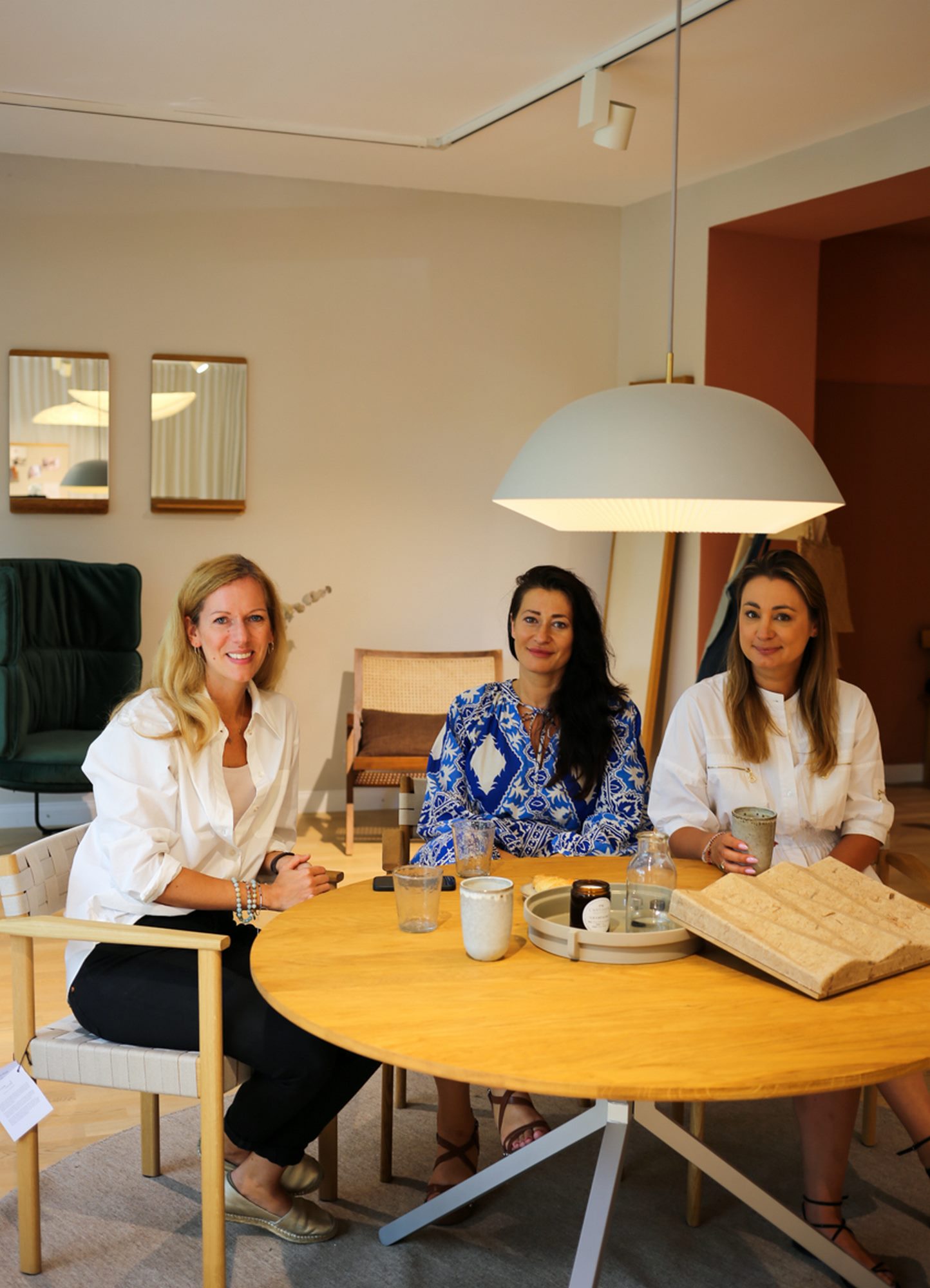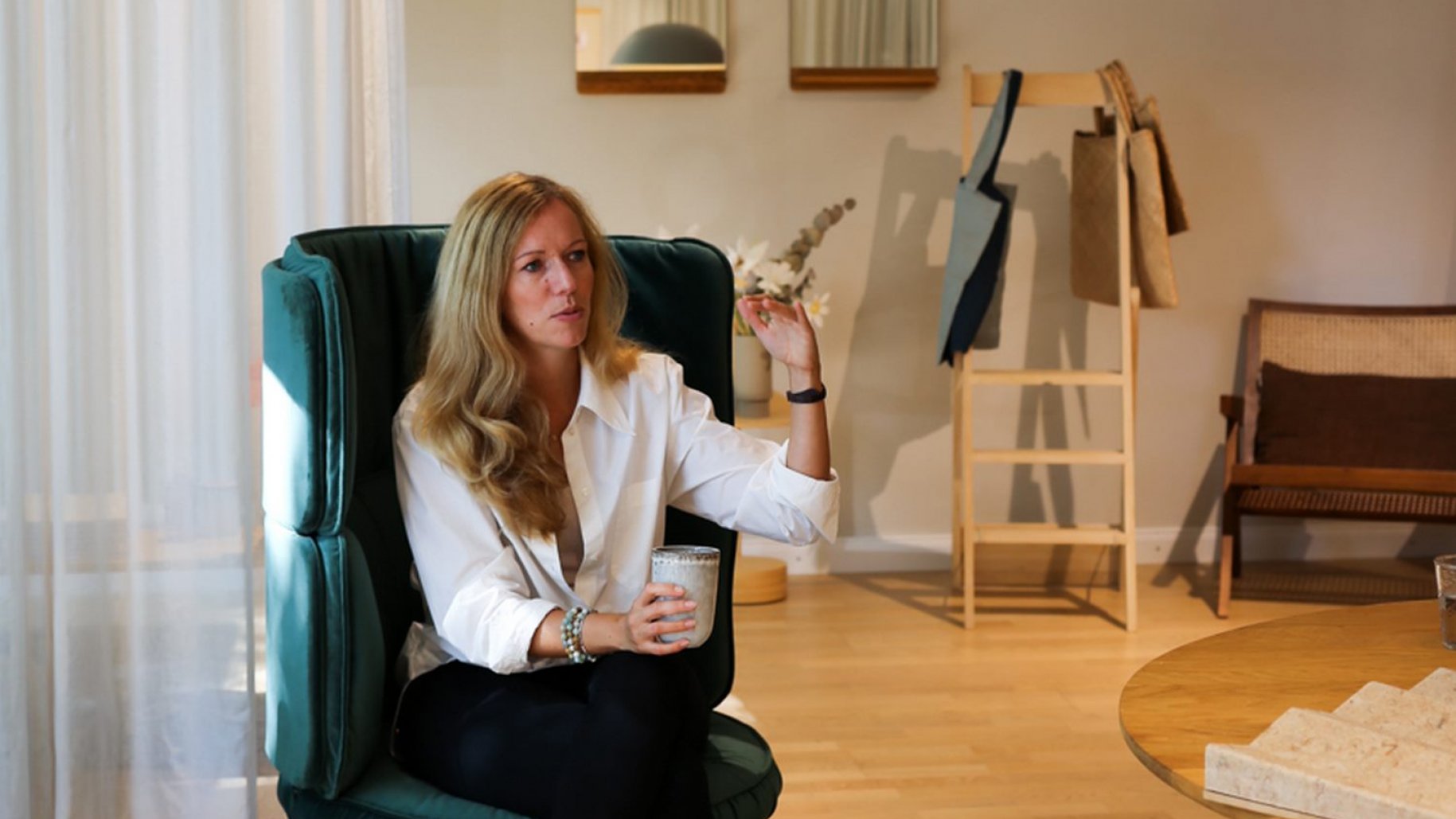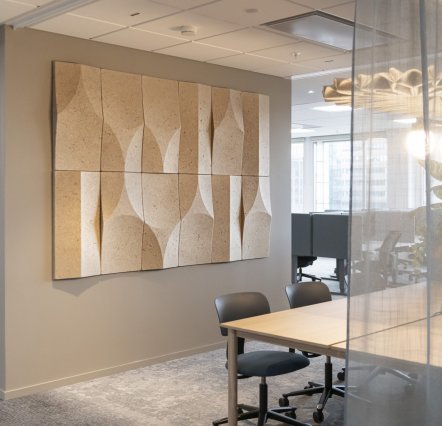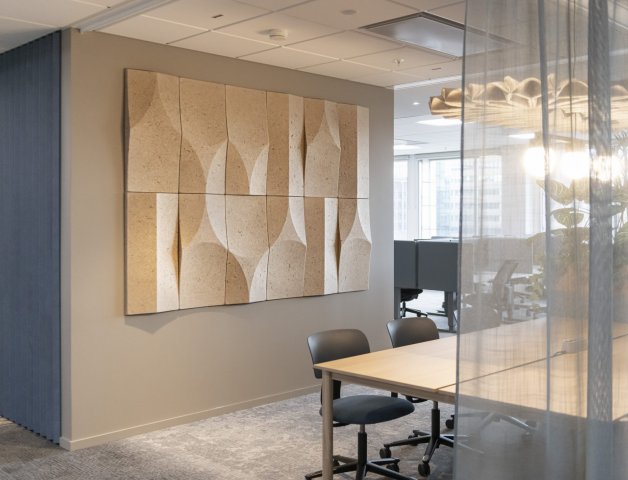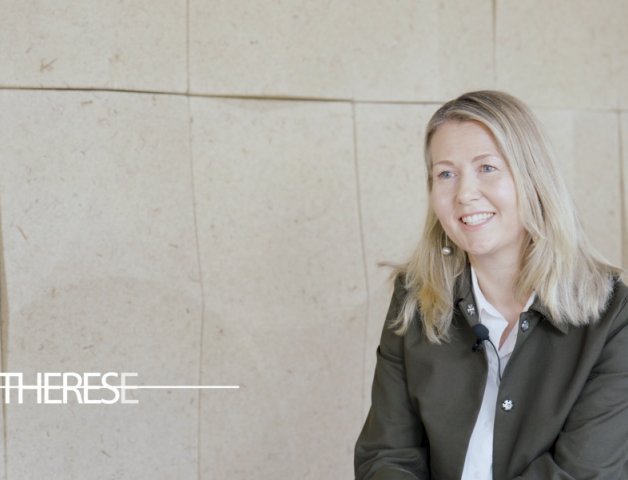Andrea Franke is the owner of Innenarchitektur Federleicht, an interior design studio located in Munich. She has extensive experience in designing offices, restaurants, shops, and residential homes worldwide. At the M.STORIES Women's Business Festival event in 2023, Andrea arranged comfortable meeting spaces using the VANK_RING collection. In the summer of that year, we visited her in the studio, which also serves as the showroom for the online shop. The shop brings together sustainable furniture, decorations, and accessories from around the world.
Rooms have a soul; they give us a home, invite us to linger or encourage us in our daily work. With love for details and passion for material and colour, we develop a design – a history – a philosophy. My aim is a pure, sustainable design that reflects your personality and supports you in your actions and being. - Andrea Franke
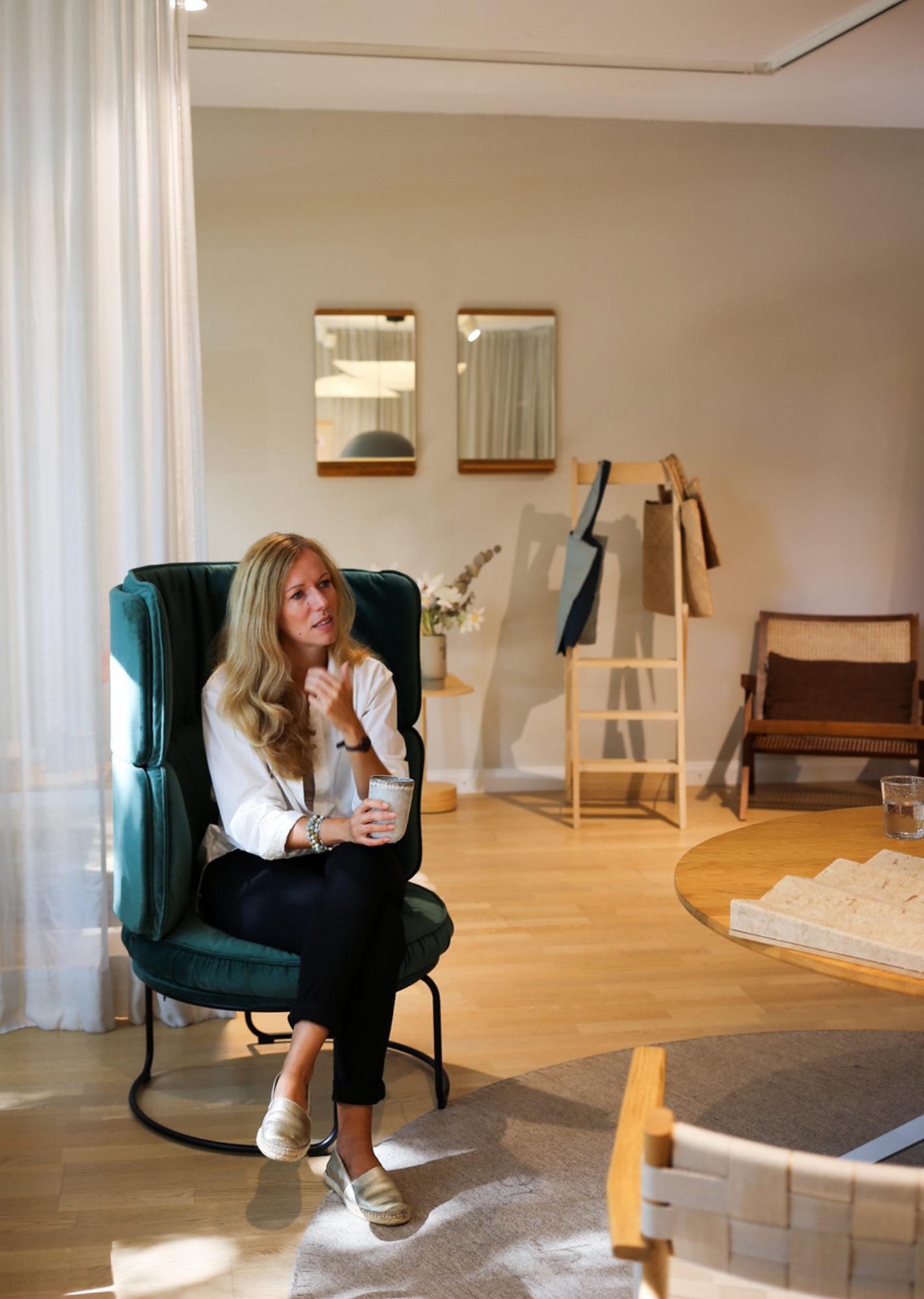
Andrea Franke sitting at VANK_RING chair
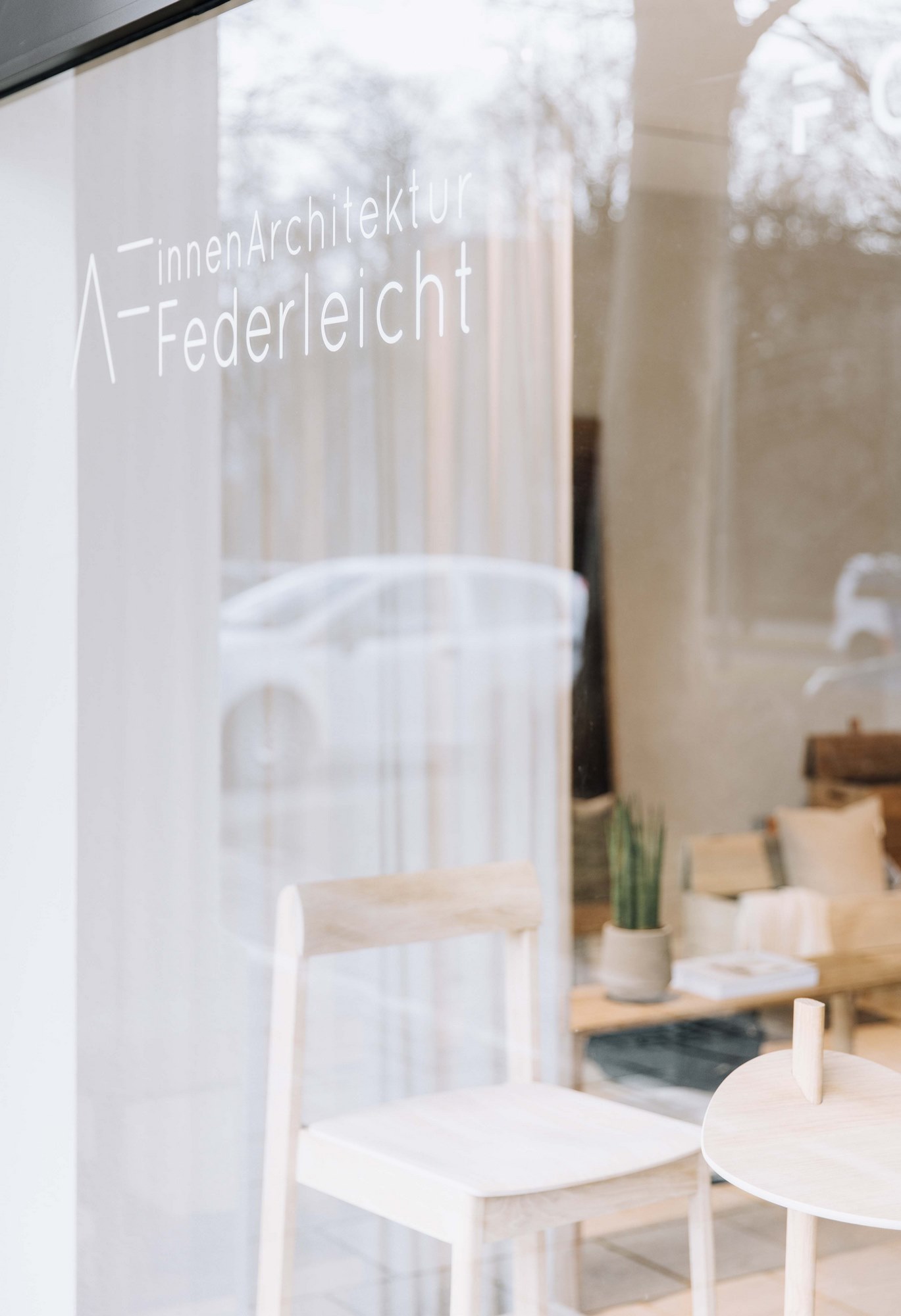
Innenarchitektur Federleicht, Marsstraße 74, Munich
VANK: Andrea, what are your preferred directions in design, art, and architecture, and how do you integrate them into your projects?
A.F.: During my student days in Copenhagen, I developed a strong affinity for Danish design, which I consider the foundation of my work. Additionally, I appreciate playful design, which is evident available in my online shop, Natural SOUL Interior. To ensure a comfortable atmosphere, we are focusing on the holiday style, also known as boho style.
It is important to note that we design for our customers and not for our own personal preferences. Therefore, we avoid designing for our ego or personal taste. My team goal is to reflect our customers' style and make them feel comfortable in their space.
VANK: I understand. You mentioned that warmth is a crucial aspect of your design. Could you elaborate on what you mean by empathetic design?
A.F.: At our company, we analyse our customers' values and incorporate them into our designs. To me, warmth represents a comfortable space where I can relax and feel at home, whether it's an office or a personal space.

Innenarchitektur Federleicht showroom in Munich, photo. Ling Khor
VANK: I think what you're getting at is that it's very important to you that users feel right at home?
A.F.: The use of precise subject-specific vocabulary is encouraged. The language used should be clear, objective, and value-neutral. The text should adhere to conventional academic structure and formatting, with consistent citation and footnote style. The text should be free from grammatical errors, spelling mistakes, and punctuation errors. The content of the improved text must be as close as possible to the source text, without any additional aspects. The design should support the functional goals of the rooms and promote values such as communication and exchange.
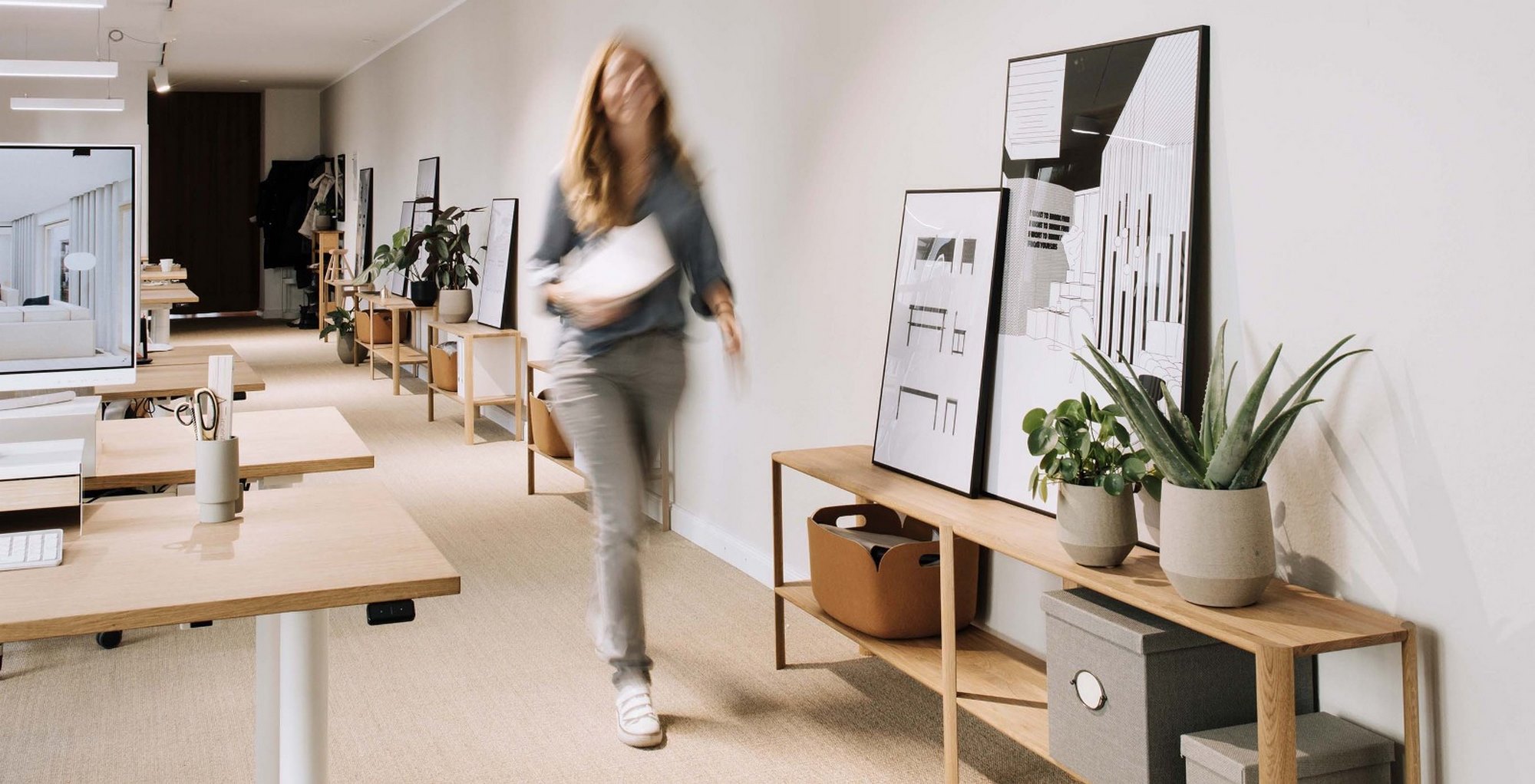
Innenarchitektur Federleicht interior design office in Munich, phot. Ling Khor
VANK: And that all sounds very romantic. Andrea, you have been running this design studio for over six years now. The studio has a strong female team. Do you focus on specific projects and investors? Does the female team have an influence on your projects?
A.F.: Interior design is a profession that is often associated with women, with an estimated 80% of students being female. However, it is important to maintain objectivity and avoid making assumptions based on gender. Sensitivity is a valuable trait in this field as it allows designers to better understand their clients' needs. To improve the design, it is important to have sensitivity towards the values it is based on and to understand the customer's perspective. This requires a more empathetic approach, which is not limited to any gender. While men may excel in technical areas, it is equally important for our job to have this sensitivity and understand the needs of our customers. Our customer base is not limited to a specific group or demographic. Rather, we aim to attract customers who appreciate our style and can identify with our brand.
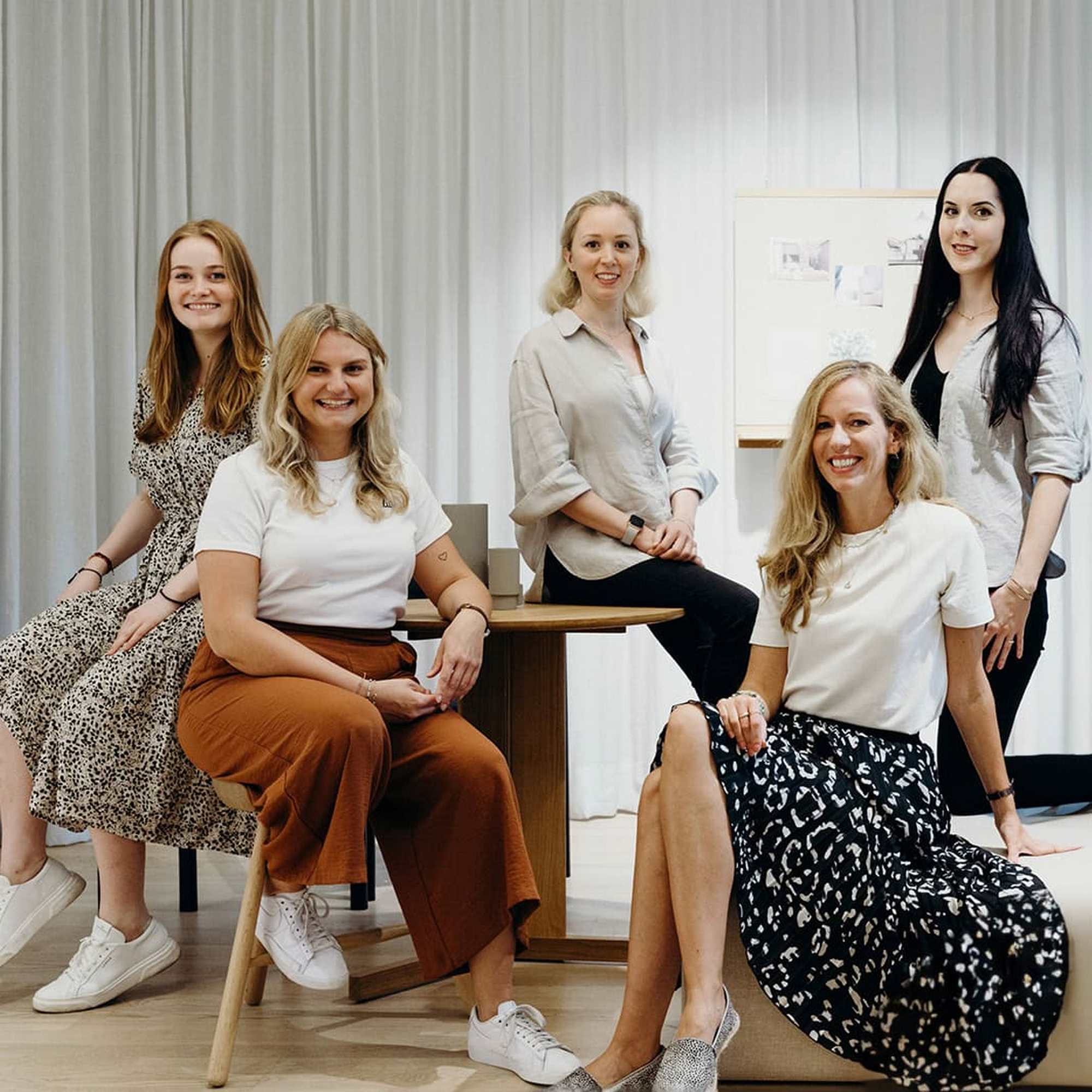
Innenarchitektur Federleicht team from Munich, phot. Ling Khor
VANK: Are decisions becoming easier for customers due to your sustainability efforts?
A.F.: Exactly, we communicate our values to the outside world. If customers can identify with them, it is easier for them to find an office that suits them. Our idea of sustainability and the psychological basis is the foundation of our theme of friendship and connection, both with our customers and within our team. This is evident in our design.
VANK: Regarding sustainability, do you have any preferred materials or fabrics for your projects? How do you research and source them?
A.F. We are interested in sustainable materials that are innovative. The use of sustainable materials made from hemp, for example, can help a business stand out in the market.
We believe that clear storytelling is crucial. Our design process focuses on transforming both the customer's and manufacturer's stories. Where do the materials come from, and why are they considered good, sustainable, and valuable?
How are the materials researched? As interior designers, we have various options. We can attend trade fairs to browse and be inspired. For example, I attended Maison&Objet in Paris this year. This trade fair is not limited to furniture but rather focuses on decoration. It provides a plethora of inspiring impressions and new materials, furniture, decorations, and manufacturers. Additionally, subscribing to newsletters can be helpful. Personal dialogue is also important to me as I value interpersonal connections. In personal conversations, I prefer to be introduced to materials and learn about their background and story. Additionally, there are platforms that specialize in material specifications or innovations, which can aid in our research.
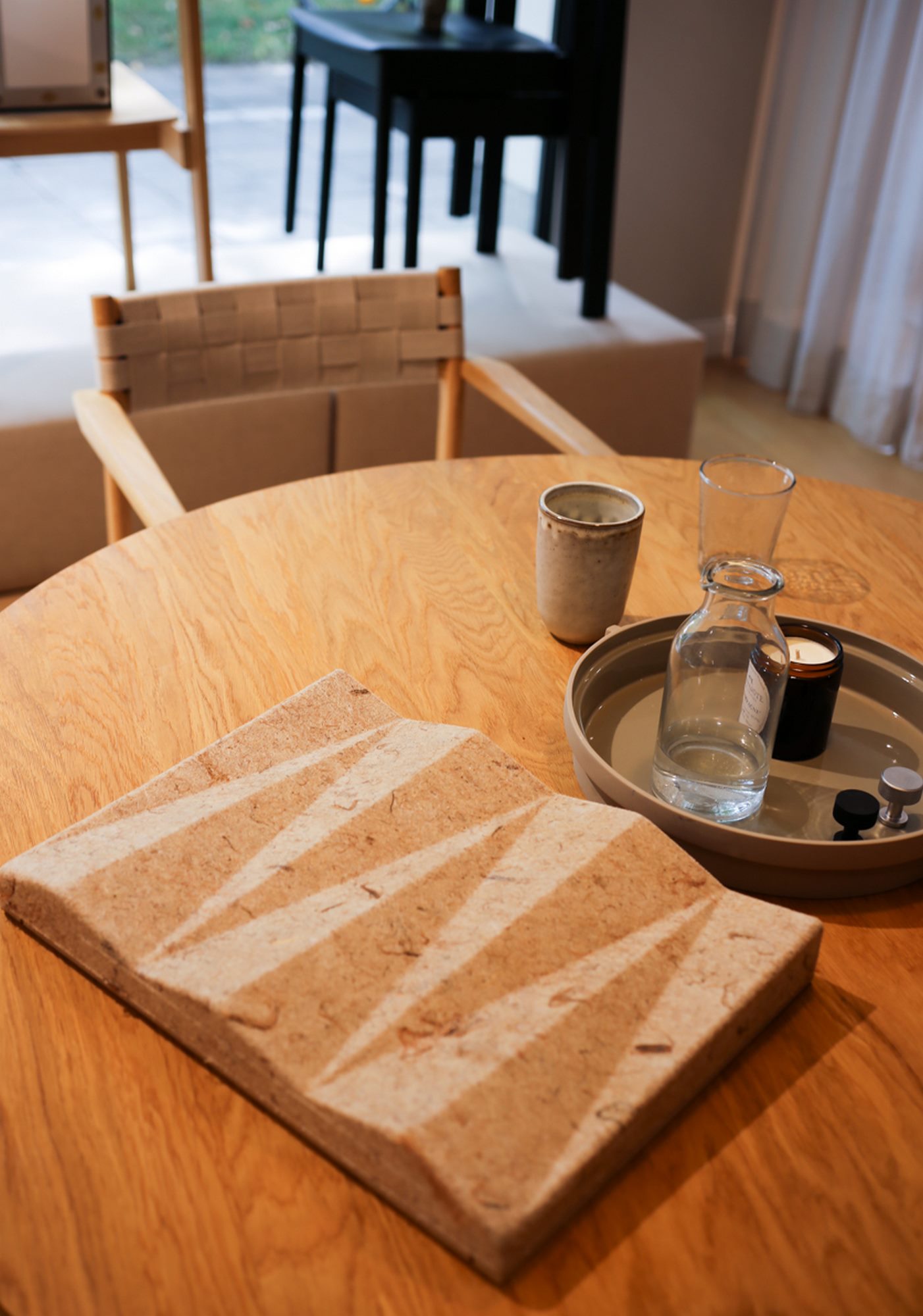
VANK_DIAMOND_BIO acoustic panel
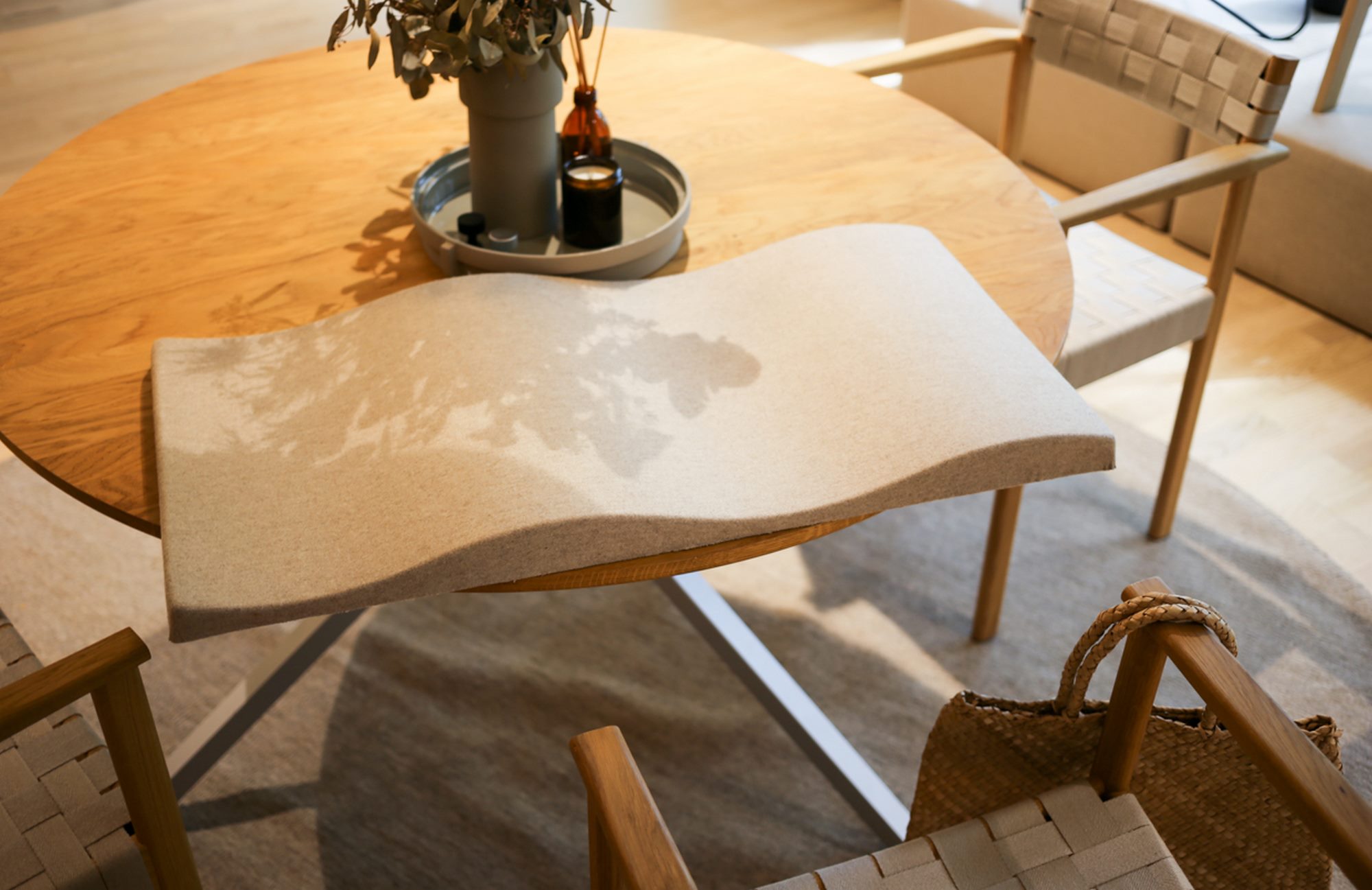
Upholstered VANK_WAVE acoustic panel
VANK: Are there any specific material libraries that you like to work with?
A.F.: I read the raumprobe newsletter regularly and find it informative. In my research, I frequently use Instagram to save material innovations from other countries. I have created various folders for this purpose and share them with my team during projects. These folders contain the latest sustainable materials and innovations that I have found. While Instagram provides a range of inspiration, Pinterest offers a diverse collection of ideas. It is important to note that these platforms should be used with objectivity and a critical eye. Instagram and Pinterest are valuable sources of inspiration for architects.
VANK: You mentioned that Federleicht distinguishes itself from the market by focusing on sustainability. The company strives to ensure that the materials used and the manufacturers in their portfolio are appropriate. Do you believe that sustainability in the office is a trend, a tendency, or has it already become established in Germany? What is your assessment of the direction this development is taking?
A.F.: Significant changes have occurred in recent years. The principle of sustainability has been implemented in our office since approximately 2019, as I also strive to act, purchase, and live sustainably in my personal life. This change was motivated by my own frustration with the lack of knowledge regarding sustainable manufacturers. During construction projects, we were occasionally overwhelmed by excessive waste, prompting me to question its necessity. That's how I ended up focusing on sustainability in interior design at Federleicht. Significant changes have occurred in recent years. The principle of sustainability has been implemented in our office since approximately 2019, as I also strive to act, purchase, and live sustainably in my personal life. This change was motivated by my own frustration with the lack of knowledge regarding sustainable manufacturers. During construction projects, we were occasionally overwhelmed by excessive waste, prompting me to question its necessity. That's how I ended up focusing on sustainability in interior design at Federleicht. Fortunately, significant progress has been made since then. As manufacturers, we have a responsibility to communicate our commitment to sustainability and the need for change. While the issue of greenwashing may be debatable, the trend towards sustainability is undeniable. The industry is evolving, and it is now easier for us to source sustainable materials. The wider range of architecture firms offering sustainable services means that we no longer stand out as much from the competition. While sustainability is being discussed more frequently, it has not yet become the norm. While sustainability is being discussed more frequently, it has not yet become the norm. It is important to note that this is just my opinion. While sustainability is being discussed more frequently, it has not yet become the norm.
Consideration was given to how to maintain a unique position in the market, as sustainability encompasses more than just the use of sustainable materials. This led to the development of value-based design, as sustainability is a significant value among others. It is imperative that this value becomes the norm for us.
Strong collaboration between planners, including architecture firms, designers, and manufacturers, is crucial. The primary objective should be to inform end-users about sustainable alternatives to conventional products. The ultimate goal is to promote sustainable projects and products. This information must be presented in a clear and concise manner, avoiding any subjective evaluations. While this may seem like a romantic vision, it is certainly achievable.
It is the responsibility of interior designers to prioritize sustainable materials and suggest them to clients whenever possible. The use of clear and concise language is essential in conveying this message. However, it is important to note that price can still be a limiting factor. When working with larger companies, it is important to pay attention to their CO2 balance. Smaller companies allow for quicker dialogue and collaborative product development. We can communicate our needs and market demands, as well as suggest desired products.
VANK: As a manufacturer, we are committed to supplying high-quality, efficient products for focused work. Do you have any tips or solutions for creating a space that promotes relaxation and concentration in project settings?
A.F.: When considering the design of a space to promote concentration and relaxation, it is important to consider the colour scheme. Neutral natural colours, as well as blue and green tones, are effective in promoting concentration by avoiding distractions. On the other hand, orange is a communicative and cheerful colour that promotes creativity, but it is not suitable for promoting concentration and relaxation. In concentration areas, we avoid using strong, dominant colours that may cause distraction.
Additionally, these areas can be structurally and acoustically shielded to enhance concentration.
To improve concentration, what are some ways to encourage acoustic measures without resorting to permanent structural options? In our office, we have a curtain solution that allows for flexibility in maintaining openness while also providing the option to separate two rooms for acoustic privacy during meetings or phone calls.
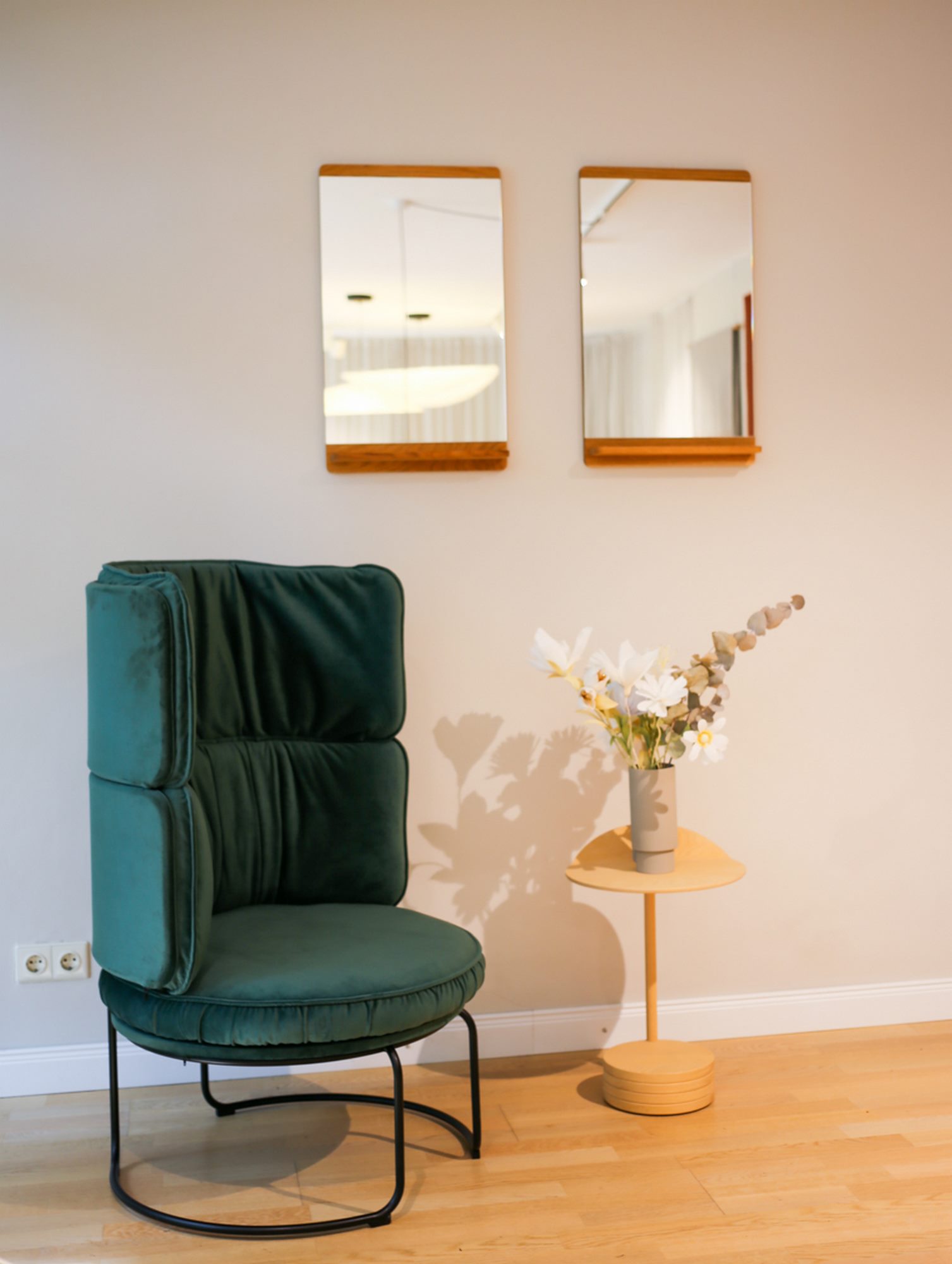
Acoustic chair VANK_RING, design: Anna Vonahusen
VANK: Do the same solutions and measures also apply to working from home?
A.F.: The topic of a home office is multifaceted. The first consideration is the number of available rooms. It is advisable to use non-permanent solutions, especially in rental apartments. Having options for keeping the workspace tidy and quickly storing away items is ideal, as it allows for a clear separation between work and personal life. For instance, closing a door is one such option. This includes storing items in cupboards and drawing curtains to keep them out of sight and out of mind. It is important to have a tidy space in order to relax in the evening. Acoustic measures are also important, especially for making calls without disturbing roommates. How can I shield myself acoustically?
VANK: Regarding home offices, what type of office environment do you think would encourage employees to give up remote work?
A.F.: I believe we are heading in the correct direction with our design. It is crucial that we feel at ease in our surroundings, whether it is an inspiring and motivating design or a comfortable and welcoming one where we can enjoy spending time with our colleagues.The design should encourage interaction between individuals and also take into account social aspects and support them. For instance, creating meeting rooms that facilitate communication. Like our own office, a courtyard where we often sit together in spring and summer, greenery is important. How can we bring nature indoors or improve the view outside? It's important to have a cohesive concept tailored to the employees, as they typically spend eight hours a day in the office and should feel comfortable there. That's why it's crucial to design for people, not just for the company's ego. The optimal design should balance the external image with the inner heart of the company, which is its employees. By doing so, everyone can enjoy coming to the office, with a mixture of opportunities for retreat, concentration, communication, and creative spaces. Creativity requires space, and we must provide it.
VANK: That sounds really exciting. Could you please provide more information on the planning process? Specifically, how does the design process unfold from the initial idea to the final result? Could you please provide more information on the planning process? Specifically, how does the design process unfold from the initial idea to the final result?
A.F.: The process begins with a needs analysis, which can be conducted through a questionnaire or a workshop with companies. The questionnaire covers functional needs and important values.
Next, a story is developed to guide the design process. An outstanding design requires a story, which can be discovered through exchanges with customers. This story can be effectively communicated within a company.
Next, the story will be converted into a mood board. The content of the improved text must remain as close as possible to the source text, without the addition of further aspects. This involves using mood images to guide the style direction, such as industrial with Scandinavian or boho elements. The language used should be clear, concise, and objective, avoiding biased or ornamental language. Technical terms should be explained when first used, and the text should be free from grammatical, spelling, and punctuation errors. It is important to consider the structural appearance of the story, including the use of blankets. Is it possible to represent different colour schemes and display images on ceilings if a floor has been specified? Can objects be transferred across the floor or even across walls and furniture? How can the story be conveyed in a structured manner? The moodboard is our preliminary draft, where we present all of these ideas.
Once the moodboard has been approved, we move on to the design and create a 3D model. We are using new programs that include real-time renderers. This means that as soon as the draft is developed, we can walk through it with the customer, using VR glasses if they wish. We can work together on changes in real time and get closer to the final draft. Good programs help the customer to have a good spatial imagination, ensuring that we are all talking about the same thing.
The final stage is implementation planning, where we plan the technical details of how the design can be implemented. During the tendering process, we invite either our network of tradespeople or external tradespeople to submit offers, which we evaluate. We then create schedules and coordinate all the way up to construction site management. Our ultimate goal is to ensure a satisfied customer with new premises.
VANK: Indeed. Andrea, it has been a very inspiring and informative conversation. We would like to thank you very much for the invitation and for your hospitality. It's great that we could meet today, and I hope this is not our last conversation.
A.F.: I hope so too. Thank you very much.
